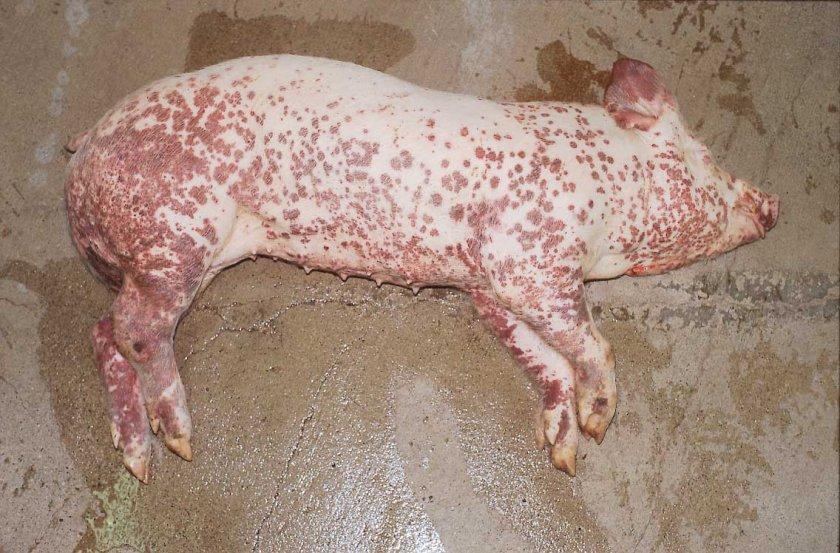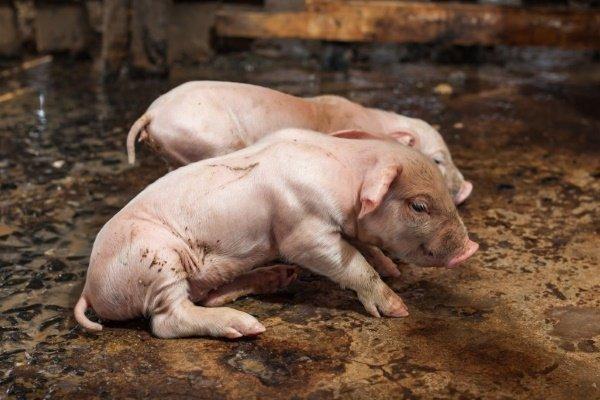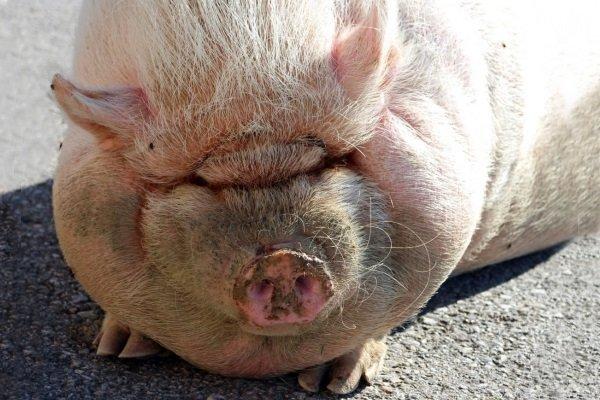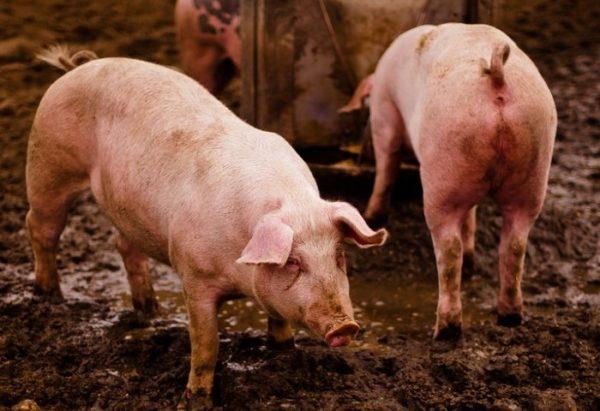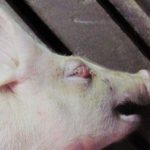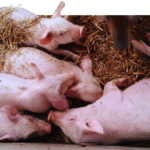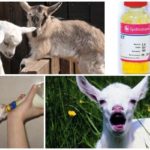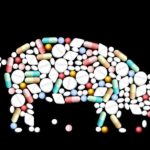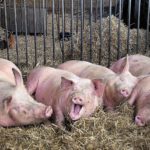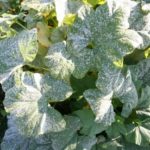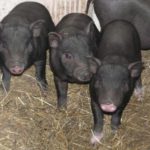Diseases of pigs are non-infectious, parasitic or infectious pathologies that can affect animals during the growing process. Before raising pigs, it is necessary to understand in more detail the ailments and their symptoms. This will help raise healthy pigs and detect the presence of a particular disease in time.
- Infectious diseases in pigs
- Plague
- Erysipelas
- Dysentery
- Edema disease of piglets
- Aujeszky's disease
- Enteroviral gastroenteritis
- Parasitic diseases
- Echinochasmosis
- Ascariasis
- Physocephalosis
- Ollulianosis (ollulanosis)
- Trichocephalosis
- Non-infectious diseases in pigs
- Cystitis
- Pneumonia
- Cholelithiasis
- Obesity
- What ails piglets
- Conclusion
Infectious diseases in pigs
Common ailments of pigs are considered to be infectious diseases. They are easily transmitted from one individual to another, and therefore one animal can infect the rest of the herd. If infections are not treated in time, they lead to the death of the sick animal.
Plague
People who raise piglets often encounter classical plague. The causative agent of the disease is considered to be pestivirus, which begins to accumulate in bile fluid, urine and blood. Thanks to this, the virus quickly spreads and infects neighboring animals that come into contact with the sick pig. Plague can be transmitted through the following:
- water;
- food;
- manure;
- litter
The disease has characteristic symptoms that indicate that the piglet has suffered from plague. These include high fever, weight loss, digestive problems, and vomiting.
Erysipelas
Appears due to the ingestion of a stationary rod that actively develops under the influence of low temperatures. If the temperature is too high, it dies. Symptoms of the disease include the following:
- skin eczema at the initial stage of development;
- fever accompanied by constipation;
- loss of appetite and weight loss.
The disease is treated with antibiotics and special medicinal serums.
Dysentery
Dysentery, like other viral diseases, can lead to the death of an animal. Therefore, it is important for a person to identify a developing disease in time. To do this, pay attention to the following symptoms:
- diarrhea, accompanied by the removal of blood and mucous fluid;
- heat;
- growth slowdown;
- change in color of feces.
To cure dysentery, the pig is given herbal medicines with antibiotics.This will slow down dehydration and relieve other symptoms.
Edema disease of piglets
This is a dangerous disease that is accompanied by impaired coordination of movements and leads to swelling of tissues or organs. The main symptom of the disease is fever. Then the animals' appetite worsens, they begin to vomit and become afraid of light. Potent antibiotics are used to treat edema.
Aujeszky's disease
This is a long-known infectious disease that was first discovered more than a hundred years ago. Most often, the disease appears in sows or individuals with weakened immune systems. The pathogen is spread through feces. Therefore, if the disease is not detected quickly, the entire herd will become infected.
Aujeszky's disease affects the nervous system of piglets, which greatly affects their behavior. They develop paralysis and begin to experience seizures.
Enteroviral gastroenteritis
It is transmitted to piglets through contaminated water or feed. Enteroviral gastroenteritis appears in small piglets up to four months old.
However, sometimes adult pigs with weakened immune systems also get sick. If left untreated, 10% of sick animals die.
Parasitic diseases
Parasitic diseases occur in pigs due to parasitic cells that enter their body. Their main feature is that they develop quickly. Parasitic diseases can be quickly treated if detected early.
Echinochasmosis
It affects the small intestine of pigs, causing them to have digestive problems. Most often, echinochasmosis appears in piglets aged 5-11 months. To quickly get rid of the disease, sick animals are given trematocidal-type drugs.
Ascariasis
The causative agent is roundworm, which penetrates the intestines of pigs. The source of infection for healthy individuals is feces, as well as food and water. Symptoms of ascariasis include high fever, slow growth and vomiting. Sick piglets are treated by deworming using medications.
Physocephalosis
It occurs as a result of parasitism in the stomach of affected pigs by the nematode scalautus. Physocephalosis has nonspecific signs, which include physical exhaustion of piglets and indigestion. The disease is very dangerous, since to this day no effective drugs have been developed for treatment.
Ollulianosis (ollulanosis)
This is a common disease that affects both young and old piglets. When olluanosis occurs in animals, digestion is disrupted, which leads to constipation, diarrhea or vomiting. If the disease is not cured in time, its aggravated form begins, during which the pigs stop eating.
Trichocephalosis
Nematodal disease, which is characterized by signs of anemia. Piglets with trichuriasis suffer from emaciation, their appetite worsens and the temperature may rise. To treat the disease, drugs such as Tetramizole, Fenbazen and Fenbendazole are used. The dosage of medication is determined by the veterinarian.
Non-infectious diseases in pigs
The safest are non-contagious, non-infectious diseases that are not transmitted from sick individuals to healthy ones.
Cystitis
This is an acute inflammation of the mucous membranes inside the bladder, which develops as a result of the penetration of a pyogenic infection. The symptoms of cystitis are specific. Sick animals have problems with urination, and sometimes their body temperature increases.It is not necessary to treat cystitis, as it goes away on its own.
Pneumonia
Some pigs suffer from pneumonia, which occurs due to weakened immunity. Symptoms of the disease include rapid heartbeat, general weakness, loss of appetite and coughing. To treat pneumonia, antibiotics are used, which should be prescribed by the attending veterinarian.
Prevention of the disease lies in proper care of animals. They need to be well fed so that they are not emaciated and weakened.
Cholelithiasis
It develops as a result of the formation of stones inside the gallbladder and its ducts. Gallstone disease can occur in animals of any age. Symptoms include bowel dysfunction, weight loss and poor appetite. To prevent the onset of the disease, more vitamins and carbohydrates are added to the diet of piglets.
Obesity
Obesity is a common disease among piglets, during which a large amount of adipose tissue accumulates in the animal's body. If a pig's weight exceeds the norm by more than 20%, it means that it is developing the initial stage of obesity. To prevent animals from gaining weight quickly, they need to be given more exercise and fed properly.
What ails piglets
Beginning farmers are interested in what diseases Vietnamese piglets suffer from. Most often, young weanlings develop the same diseases as adults. Common diseases include furunculosis, pneumonia, gastroenteritis, and erysipelas. Pot-bellied pigs sometimes develop hypoglycemia.
Conclusion
People who are going to raise pigs should become familiar with their diseases. This will help in the future to quickly diagnose and treat the animal.

